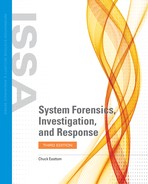The Daubert Standard
One legal principle that is key to forensics and is all too often overlooked in forensic books is the Daubert standard. The Cornell University Law School defines the Daubert standard as follows:
Standard used by a trial judge to make a preliminary assessment of whether an expert’s scientific testimony is based on reasoning or methodology that is scientifically valid and can properly be applied to the facts at issue. Under this standard, the factors that may be considered in determining whether the methodology is valid are: (1) whether the theory or technique in question can be and has been tested; (2) whether it has been subjected to peer review and publication; (3) its known or potential error rate; (4) the existence and maintenance of standards controlling its operation; and (5) whether it has attracted widespread acceptance within a relevant scientific community.
What this means, in layman’s terms, is that any scientific evidence presented in a trial has to have been reviewed and tested by the relevant scientific community. For a computer forensics investigator, that means that any tools, techniques, or processes you utilize in your investigation should be ones that are widely accepted in the computer forensics community. You cannot simply make up new tests or procedures.
This, naturally, brings up the question, how do new techniques become widely accepted? Let’s suppose you have developed a new tool that extracts forensic information from the Windows Registry. A first step might be to provide a copy of that tool to a few professors of forensics, allowing them to experiment with it. You might also publish an article describing it. After it has been tested by the forensic community and articles about it have been read (and possibly rebutted), then your tool would be usable in real forensic investigations.
It is important to remember the Daubert standard because it will affect your forensic approach. It also reminds us of an even more basic concept: The evidence you collect is important only if it is admissible in court. So you have to pay attention to the techniques and tools you use and maintain the chain of custody.
If you fail to use widely accepted techniques, to fully document your methodology, and to use only those tools and techniques you are qualified to use, the opposing attorney might issue what is commonly called a Daubert challenge. This is a motion to exclude all or part of your testimony due to it failing to meet the Daubert standard. Daubert challenges are quite common in civil cases, but are not common in criminal court. There has been a movement in the legal community in recent years to increase Daubert challenges in criminal court. The rationale behind this is that some people believe that “junk science” is making its way into criminal proceedings, and well-articulated Daubert challenges could reduce that.
